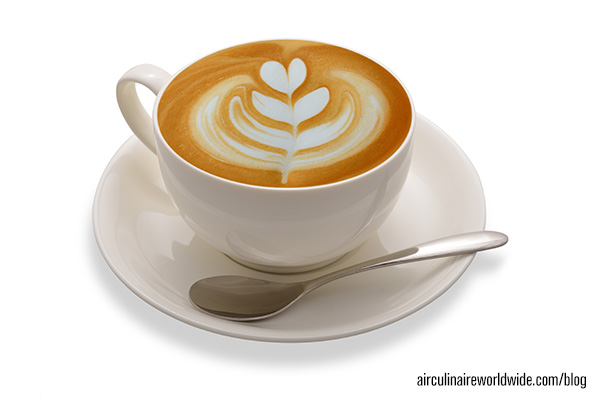As a corporate flight attendant, you may want to add “barista” to your list of skills. In order to make a lasting impression on your coffee loving passengers, let’s explore the basics. Gourmet typically refers to food products that are the most sought after by consumers, as they are of the highest achievable quality. This is also true for coffee, but it is as much gourmet as it is a product that should be produced by artisans within their field.
Essentially, being a barista is akin to being a chef at a gourmet dining experience. Baristas take a carefully crafted food item and presenting it at its best. A good barista should take personal time with the coffee to understand the different facets and flavour notes they can bring out; this is called cupping.
Cupping is an essential part of understanding a single origin coffee and from that we can decide if we want to blend it with other single origin coffee, or leave it as a stand alone coffee. It is arguably easier to pick out the qualities and flavour notes of a single origin rather than a blended coffee, which can be quite complex in character.
After you have gone through the process of cupping, you should have some understanding of the coffees at your disposal and therefore can chose to either create a gourmet blend using flavour notes of different coffees that would compliment one another. For example, the note of chocolate in single origin Guatemalan accompanied by the lighter, fruiter notes of a single origin Rwandan, or choose a single estate to serve which you feel has enough complexity to satisfy your passengers.
Once you have found a coffee that you are confident in, you will then need to take your creation and extract it in the best possible way to bring out the flavour notes you discovered during cupping. This can be through a variety of brew methods, which comes to own from the preference of your passengers and available equipment in your galley, the most common being a “cafeteria” (French press) or an espresso machine.
The responsibility that a barista has is equal to that of the coffee roaster or the coffee grower, as the best and most simple of coffees can be ruined by poor extraction, or bad practice at the machine. Essentially, a barista is responsible for taking care when representing this coffee and all of the hard work that has gone into the growing, roasting and blending of the coffee before it even reaches the your aircraft.
This is what distinguishes an artisan barista from a coffee enthusiast.
Types of Coffee
There are two main types of coffee: Robusta, which is known for its high caffeine content and less refined taste, and Arabica, known for its more favourable complex flavour notes, which makes it the more appealing of the two. However, Arabica is more expensive. All coffees are given a grade between 1 and 5, with 5 being very poor quality beans with a lot of imperfections, typically used for instant freeze-dried coffee, and 1 being an almost flawless batch of coffee. Grades 1 and 2 contribute to roughly 20% of all coffee grown currently. However, there still is not enough available to supply every popular coffee chain retailer, so they have to settle for grade 3 and 4 coffees. With this said, the consumer is more concerned with which type of coffee ends up in their cup, which amounts to a plethora of different coffee recipes with more being invented everyday. The most common are Americano, espresso, latte and cappuccino, which almost everyone around the world are familiar with.
Espresso is the basis of all beverages made from an espresso machine and therefore the most important to extract correctly.
Arguably the most difficult to serve correctly, an espresso consists of 30mL of water laced with highly concentrated coffee that has been pressed out at nine bars of pressure. Hence the name “espresso,” the Italian phrase for “pressed out.” The reason it is so difficult to serve properly, is because there is a very specific method to extracting an espresso shot that fully utilises the flavour notes of the coffee. A few seconds either side of the extraction recipe can ruin an otherwise perfect shot that could be served to a passenger with confidence.
The reason I touch upon this in such detail is that every barista spends their first training session learning about everything that goes into an espresso, as it is that important.
Coffee In-flight
The main issues with serving espresso at altitude stem from an espresso machine being held at pressure when being used, as well as the difficulty of presenting an aesthetically pleasing coffee whilst moving.
To address the first, an espresso machine is held at 15 bars internal pressure, which translate to 9 bars at the grouphead, where the espresso is pressed out. Maintaining this pressure is essential, as each minute change to the extraction process can greatly affect the end result. Changes in cabin pressure could possibly have some affect on the internal pressure of the boiler, thus effecting the overall extraction.
The second issue relates more to presentation, as to pour consistent latte or cappuccino art requires a steady hand, which can obviously be hindered by turbulence or the sudden movement of an aircraft; meaning that flight attendants should take care when attempting to produce a high-quality beverage under difficult circumstances.
| This article was written by Jack Tomkins, co-owner of The Daily Grind: Artisan Coffee and gourmet coffee enthusiast. Jack gained his experience working with different varieties of gourmet coffee blends and is currently training to compete in this year’s Speciality Coffee Association of Europe (SCAE) Latte Art competition, with the intention of competing in the World Barista Championship. Contact him at thedailygrindac@hotmail.com. Any thoughts expressed in this article are entirely Jacks’s and do not necessarily reflect the views of Air Culinaire Worldwide. |
If you would like to be considered for becoming a guest author, please contact socialmedia@airculinaire.com.





